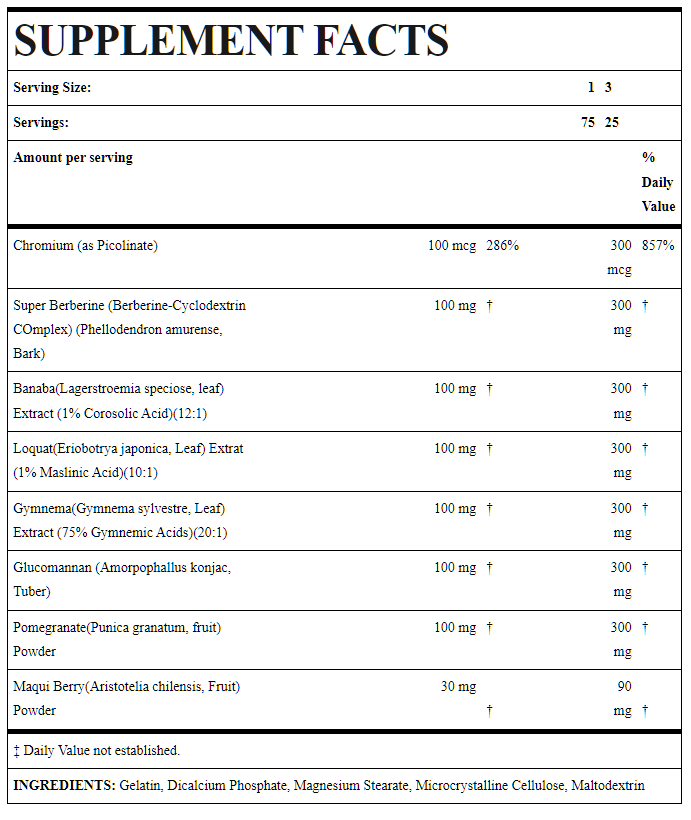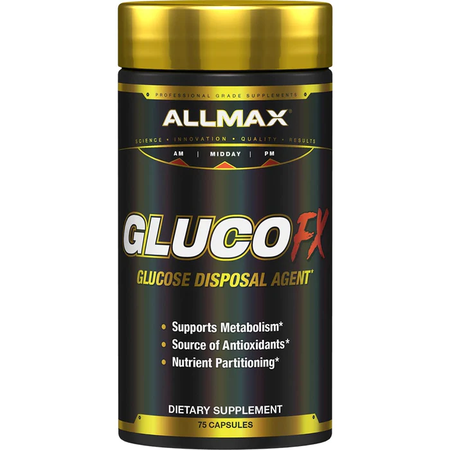AllMax Nutrition GlucoFX (Glucose Disposal Agent) - 75 Cap Item #: AMX194UPC: 665553229072
$17.48 $13.98
20% Off Special Offer
GLUCOSE DISPOSAL AGENT
PUT GLUCOSE WHERE IT BELONGS…IN THE MUSCLE!
How does GLUCO FX work to produce its unparalleled advantages and what can it’s combined ingredients do for you? Let’s take a look at what this innovative new product does and its science-supported ingredients.
Super Berberine
4, 12, 18 5
Chromium
Maqui Berry
1, 10 20
Pomegranate
Banaba Leaf Extract
17 It does this by activating insulin receptors on muscle tissue, a mechanism that automatically lowers blood glucose levels. 6, 7, 13, 14, 15
Banaba inhibits fat cell production resulting from caloric overconsumption. Important for bodybuilders who want full, round muscle bellies and ample training energy is Banaba’s ability to increase the expression and activation of GLUT-4, a transporter protein that allows glucose to be absorbed into the cells of the body. 3, 11
Loquat Extract
19 9, 16
Gymnema Sylvestre (75% Gymnemic Shrubs)
Gymnema Sylvestre effectively soaks up excess glucose and shuttles it where it belongs. One of its primary active components, gymnemic acid, is known for suppressing cravings for sweet foods by blocking the sugar receptors on the taste buds. 8 Indeed, study subjects who received Gymnema Sylvestre were found to have less appetite for sweet foods at subsequent meals and were more likely to limit their food intake. 2
THE INSULIN ADVANTAGE
HOW TO STACK GLUCO FX 21, 22, 23
THE GLUCO FX DIFFERENCE
*These statements have not been evaluated by the Food and Drug Administration. This product is not intended to diagnose, treat, cure or prevent any disease.
Alvarado, J. et al. (2016). Delphinol® standardized maqui berry extract significantly lowers blood glucose and improves blood lipid profile in prediabetic individuals in three-month clinical trial. Panminerva Med. Sep;58(3 Suppl 1):1-6. Brala, P.M. et al. (1983). Effects of sweetness perception and caloric value of a preload on short term intake. Physiol Behav. Jan;30(1):1-9. Guo S. et al. (2020). The anti-diabetic effect of eight Lagerstroemia speciosa leaf extracts based on the contents of ellagitannins and ellagic acid derivatives. Food Funct. Feb 26;11(2):1560-1571. Habtemarium, S. et al. (2020). Berberine pharmacology and the gut microbiota: A hidden therapeutic link Pharmacological Research Volume 155, May, 104722 Hu, Y. et al. (2012). Lipid-lowering effect of berberine in human subjects and rats Phytomedicine Volume 19, Issue 10, 15 July Pages 861-867 Hou, W. et al. (2009). Triterpene acids isolated from Lagerstroemia speciosa leaves as alpha-glucosidase inhibitors. Phytother Res. May;23(5):614-8. Judy, W. V. et al. (2003). Antidiabetic activity of a standardized extract (GlucosolTM) from Lagerstroemia speciosa leaves in Type II diabetics A dose-dependence study Journal of Ethnopharmacology 87 115–117 Kanetkar, P. et al. (2007) Gymnema sylvestre: A Memoir. J Clin Biochem Nutr. Sep;41(2):77-81. Liu, Y. et al. (2016). Biological Activities of Extracts from Loquat (Eriobotrya japonica Lindl.): A Review. International journal of molecular sciences, 17(12), 1983. Mistle, E. et al. (2011). Maqui [Aristotelia chilensis (Mol.) Stuntz]-the Amazing Chilean Tree: A Review Journal of Agricultural Science and Technology B 1 473-482 Miura, T. et al. (2012). Management of Diabetes and Its Complications with Banaba (Lagerstroemia speciosa L.) and Corosolic Acid. Evidence-based complementary and alternative medicine : eCAM, 2012, 871495. Pang, B. et al. (2015). Application of berberine on treating type 2 diabetes mellitus. Int J Endocrinol. 905749. Sharmin, T. et al. (2018). Investigation of biological activities of the flowers of Lagerstroemia speciosa, the Jarul flower of Bangladesh. BMC complementary and alternative medicine, 18(1), 231. Shi, L. et al. (208). Corosolic acid stimulates glucose uptake via enhancing insulin receptor phosphorylation. Eur J Pharmacol. Apr 14;584(1):21-9. Stohs, S.J. et al. (2012). A review of the efficacy and safety of banaba (Lagerstroemia speciosa L.) and corosolic acid. Phytother Res. 2012 Mar;26(3):317-24. Tanaka, K. et al. (2008). Hypoglycemic activity of Eriobotrya japonica seeds in type 2 diabetic rats and mice. Biosci Biotechnol Biochem. Mar;72(3):686-93. Ulbricht, C. et al. (2007). Banaba (Lagerstroemia speciosa L.): An Evidence-Based Systematic Review by the Natural Standard Research Collaboration Journal of Herbal Pharmacotherapy, Vol. 7(1) Yin, J. et al. (2008). Efficacy of Berberine in Patients with Type 2 Diabetes Metabolism. May; 57(5): 712–717. Zhou, C. et al. (2011). Flavonoids, Phenolics, and Antioxidant Capacity in the Flower of Eriobotrya japonica Lindl. Int. J. Mol. Sci. 2011, 12, 2935-2945 Wedick, N.M. et al. (2012). Dietary flavonoid intakes and risk of type 2 diabetes in US men and women. Am J Clin Nutr. Apr;95(4):925-33. Feb 22. Aguiar, A. et al. (2017). Free leucine supplementation during an 8-week resistance training program does not increase muscle mass and strength in untrained young adult subjects. Amino Acids. 2017 Jul;49(7):1255-1262. Jackman, S. et al. (2017). Branched-Chain Amino Acid Ingestion Stimulates Muscle Myofibrillar Protein Synthesis Following Resistance Exercise in Humans. Front. Physiol. 8:390. Moberg, M. et al. (2016). Activation of mTORC1 by leucine is potentiated by branched-chain amino acids and even more so by essential amino acids following resistance exercise. Am. J. Physiol. Cell Physiol. 310, C874–C884. Copyright 2019 - 2024 DPS Nutrition
[{"u":"\/b\/486002\/3d-energy-drink.htm","n":"3D Energy Drink"},{"u":"\/b\/486038\/5-hour-energy.htm","n":"5 Hour Energy"},{"u":"\/b\/466\/5-nutrition.htm","n":"5% Nutrition"},{"u":"\/b\/486028\/ab-fx.htm","n":"AB Fx"},{"u":"\/b\/5\/american-bodybuilding.htm","n":"ABB American Bodybuilding"},{"u":"\/b\/486069\/abe-nation.htm","n":"ABE Nation"},{"u":"\/b\/486041\/abl-pharma.htm","n":"ABL Pharma"},{"u":"\/b\/486075\/afterdark.htm","n":"AfterDark"},{"u":"\/b\/486018\/alani-nu-energy-drink.htm","n":"Alani Nu"},{"u":"\/b\/411\/allmax-nutrition.htm","n":"AllMax Nutrition"},{"u":"\/b\/446\/alpha-gainz.htm","n":"Alpha Gainz"},{"u":"\/b\/486023\/alpha-lion.htm","n":"Alpha Lion"},{"u":"\/b\/4\/alri.htm","n":"ALRI"},{"u":"\/b\/486053\/anabar.htm","n":"Anabar"},{"u":"\/b\/486070\/animal-factory.htm","n":"Animal Factory"},{"u":"\/b\/188\/animal-products.htm","n":"ANIMAL Pak"},{"u":"\/b\/9\/ansi.htm","n":"ANSI Nutrition"},{"u":"\/b\/461\/apollon-nutrition.htm","n":"Apollon Nutrition"},{"u":"\/b\/204\/aps-nutrition.htm","n":"APS Nutrition"},{"u":"\/b\/486049\/arms-race-nutrition.htm","n":"Arms Race Nutrition"},{"u":"\/b\/486007\/axe-sledge.htm","n":"Axe & Sledge"},{"u":"\/b\/486037\/axis-labs.htm","n":"Axis Labs"},{"u":"\/b\/486060\/bang-energy.htm","n":"Bang Energy"},{"u":"\/b\/486031\/barebells-protein-bars.htm","n":"Barebells Protein Bars"},{"u":"\/b\/486084\/beast-bites-creatine-gummies.htm","n":"Beast Bites Creatine Gummies"},{"u":"\/b\/15\/beverly-international.htm","n":"Beverly International"},{"u":"\/b\/449\/black-magic-supply-co..htm","n":"Black Magic Supply Co."},{"u":"\/b\/471\/black-market-labs.htm","n":"BlackMarket Labs"},{"u":"\/b\/391\/blackstone-labs.htm","n":"Blackstone Labs"},{"u":"\/b\/1\/ab-fx-cream.htm","n":"Body FX Ab-Fx"},{"u":"\/b\/486039\/bpi-sports.htm","n":"BPI Sports"},{"u":"\/b\/17\/bsn.htm","n":"BSN"},{"u":"\/b\/470\/bucked-up.htm","n":"Bucked Up"},{"u":"\/b\/474\/built-bar.htm","n":"Built Bars"},{"u":"\/b\/486082\/bum-energy.htm","n":"BUM Energy"},{"u":"\/b\/486047\/cbum.htm","n":"CBUM"},{"u":"\/b\/296\/cellucor.htm","n":"Cellucor"},{"u":"\/b\/486017\/celsius-rtd.htm","n":"Celsius RTD"},{"u":"\/b\/457\/chemix.htm","n":"Chemix"},{"u":"\/b\/486019\/chike-nutrition.htm","n":"Chike Nutrition"},{"u":"\/b\/155\/competitive-edge-labs.htm","n":"Competitive Edge Labs CEL"},{"u":"\/b\/214\/con-cret.htm","n":"CON-CR\u0112T Creatine"},{"u":"\/b\/486064\/condemned-labz.htm","n":"Condemned Labz"},{"u":"\/b\/21\/controlled-labs.htm","n":"Controlled Labs"},{"u":"\/b\/312\/convenient-nutrition.htm","n":"Convenient Nutrition"},{"u":"\/b\/142\/core-nutritionals.htm","n":"Core Nutritionals"},{"u":"\/b\/23\/cytosport.htm","n":"Cytosport"},{"u":"\/b\/355\/deluxe-whey.htm","n":"Deluxe Whey Protein"},{"u":"\/b\/30\/dps-nutrition.htm","n":"Dps Nutrition"},{"u":"\/b\/32\/dymatize.htm","n":"Dymatize"},{"u":"\/b\/33\/eas.htm","n":"EAS"},{"u":"\/b\/34\/eclipse.htm","n":"Eclipse Sports Supplements"},{"u":"\/b\/194\/efx-sports.htm","n":"EFX Sports"},{"u":"\/b\/486071\/ephlabs.htm","n":"EHPlabs"},{"u":"\/b\/408\/epg.htm","n":"EPG Extreme Products"},{"u":"\/b\/322\/evomuse.htm","n":"EvoMuse"},{"u":"\/b\/486079\/fit-bar.htm","n":"Fit Bar"},{"u":"\/b\/486048\/fit-butters.htm","n":"Fit Butters"},{"u":"\/b\/412\/fit-crunch.htm","n":"Fit Crunch Bars"},{"u":"\/b\/41\/gaspari-nutrition.htm","n":"Gaspari Nutrition"},{"u":"\/b\/43\/gat.htm","n":"GAT Sport"},{"u":"\/b\/464\/g-code-nutrition.htm","n":"GCode Nutrition"},{"u":"\/b\/486010\/ghost-energy-drink.htm","n":"Ghost Energy"},{"u":"\/b\/44\/gift-certificates.htm","n":"Gift Certificates"},{"u":"\/b\/482\/glaxon.htm","n":"Glaxon"},{"u":"\/b\/486080\/gorilla-mind.htm","n":"Gorilla Mind"},{"u":"\/b\/486059\/grizzly-fitness.htm","n":"Grizzly Fitness"},{"u":"\/b\/485\/hanks-protein-plus.htm","n":"Hank's Protein Plus"},{"u":"\/b\/343\/hardrock-supplements.htm","n":"HardRock Supplements"},{"u":"\/b\/46\/hi-tech-pharmaceuticals.htm","n":"Hi Tech Pharmaceuticals"},{"u":"\/b\/126\/liv-52.htm","n":"Himalaya"},{"u":"\/b\/486062\/hypd-supps.htm","n":"Hypd Supps"},{"u":"\/b\/434\/dermacrine-topical.htm","n":"Iconic Formulations"},{"u":"\/b\/146\/i-force-nutrition.htm","n":"iForce Nutrition"},{"u":"\/b\/472\/innovapharm.htm","n":"InnovaPharm"},{"u":"\/b\/486076\/inspired-nutra.htm","n":"Inspired Nutra"},{"u":"\/b\/447\/iron-legion.htm","n":"Iron Legion"},{"u":"\/b\/415\/isopure.htm","n":"Isopure"},{"u":"\/b\/486074\/jocko-fuel.htm","n":"Jocko Fuel"},{"u":"\/b\/486068\/jst-wrk-energy.htm","n":"JST WRK Energy"},{"u":"\/b\/486056\/jym-supplement-science.htm","n":"JYM Supplement Science"},{"u":"\/b\/407\/kaged-muscle.htm","n":"Kaged Muscle"},{"u":"\/b\/486051\/klout.htm","n":"Klout"},{"u":"\/b\/56\/labrada.htm","n":"Labrada Nutrition"},{"u":"\/b\/483\/legendary-foods.htm","n":"Legendary Foods"},{"u":"\/b\/379\/lenny-larrys-cookies.htm","n":"Lenny & Larry's Cookies"},{"u":"\/b\/486067\/life-extension.htm","n":"Life Extension"},{"u":"\/b\/486057\/liquid-grip.htm","n":"Liquid Grip"},{"u":"\/b\/486044\/liquid-i.v..htm","n":"Liquid I.V."},{"u":"\/b\/486043\/lmnt-elemental-labs.htm","n":"LMNT Elemental Labs"},{"u":"\/b\/58\/man-sports.htm","n":"Man Sports"},{"u":"\/b\/427\/merica-labz.htm","n":"Merica Labz"},{"u":"\/b\/59\/met-rx.htm","n":"Met-Rx"},{"u":"\/b\/286\/metabolic-nutrition.htm","n":"Metabolic Nutrition"},{"u":"\/b\/60\/mhp.htm","n":"MHP"},{"u":"\/b\/61\/molecular-nutrition.htm","n":"Molecular Nutrition"},{"u":"\/b\/385\/muscle-addiction.htm","n":"Muscle Addiction"},{"u":"\/b\/486054\/muscle-milk.htm","n":"Muscle Milk"},{"u":"\/b\/64\/muscle-sandwich.htm","n":"Muscle Sandwich"},{"u":"\/b\/277\/musclemeds.htm","n":"MuscleMeds"},{"u":"\/b\/66\/muscletech.htm","n":"MuscleTech"},{"u":"\/b\/417\/mutant.htm","n":"Mutant"},{"u":"\/b\/486003\/myogenix.htm","n":"Myogenix"},{"u":"\/b\/68\/natures-best.htm","n":"Natures Best"},{"u":"\/b\/72\/now-foods.htm","n":"Now Foods"},{"u":"\/b\/371\/nutrakey.htm","n":"Nutrakey"},{"u":"\/b\/486078\/nutrapur.htm","n":"NutraPUR"},{"u":"\/b\/348\/nuts-n-more.htm","n":"Nuts 'n More"},{"u":"\/b\/486034\/ohana-liquid-protein.htm","n":"Ohana Liquid Protein"},{"u":"\/b\/442\/one-bars.htm","n":"ONE Bars"},{"u":"\/b\/77\/optimum-nutrition.htm","n":"Optimum Nutrition - ON"},{"u":"\/b\/78\/ostrim.htm","n":"Ostrim"},{"u":"\/b\/486066\/panda-supps.htm","n":"Panda Supps"},{"u":"\/b\/398\/performax-labs.htm","n":"Performax Labs"},{"u":"\/b\/253\/pes-performance-enhancing-supplements.htm","n":"PEScience"},{"u":"\/b\/127\/power-crunch-bars.htm","n":"Power Crunch Bars"},{"u":"\/b\/486073\/powered-by-plants.htm","n":"Powered by Plants"},{"u":"\/b\/486083\/premier-protein.htm","n":"Premier Protein"},{"u":"\/b\/486027\/ap-sports-regimen.htm","n":"Prime Bites"},{"u":"\/b\/414\/primeval-labs.htm","n":"Primeval Labs"},{"u":"\/b\/486050\/professor-nutz-peanut-butter.htm","n":"Professor Nutz Peanut Butter"},{"u":"\/b\/486033\/project-ad.htm","n":"Project AD"},{"u":"\/b\/435\/psycho-pharma.htm","n":"Psycho Pharma"},{"u":"\/b\/486085\/pump-sauce.htm","n":"Pump Sauce"},{"u":"\/b\/331\/pure-protein.htm","n":"Pure Protein"},{"u":"\/b\/220\/purus-labs.htm","n":"Purus Labs"},{"u":"\/b\/260\/quest-bar.htm","n":"Quest Nutrition"},{"u":"\/b\/486008\/raw-nutrition.htm","n":"Raw Nutrition"},{"u":"\/b\/418\/redcon1.htm","n":"RedCon1"},{"u":"\/b\/486086\/redefine-foods.htm","n":"Redefine Foods"},{"u":"\/b\/486061\/redline.htm","n":"Redline"},{"u":"\/b\/486013\/repp-sports.htm","n":"Repp Sports"},{"u":"\/b\/486012\/revive-md.htm","n":"Revive"},{"u":"\/b\/486065\/rule-1.htm","n":"Rule 1"},{"u":"\/b\/452\/ryse-supplements.htm","n":"RYSE"},{"u":"\/b\/91\/serious-nutrition-solutions.htm","n":"SNS Serious Nutrition Solutions"},{"u":"\/b\/210\/species-nutrition.htm","n":"Species Nutrition"},{"u":"\/b\/486052\/sport-shaker.htm","n":"SportShaker"},{"u":"\/b\/486035\/train-naked-labs.htm","n":"Train Naked Labs"},{"u":"\/b\/108\/ultimate-nutrition.htm","n":"Ultimate Nutrition"},{"u":"\/b\/109\/universal-nutrition.htm","n":"Universal Nutrition"},{"u":"\/b\/130\/usp-labs.htm","n":"Usp Labs"},{"u":"\/b\/216\/vigor-labs.htm","n":"Vigor Labs"},{"u":"\/b\/370\/vmi-sports.htm","n":"VMI Sports"},{"u":"\/b\/113\/vpx-sports.htm","n":"Vpx Sports"},{"u":"\/b\/463\/xtreme-performance-gels.htm","n":"XPG Xtreme Performance Gels"},{"u":"\/b\/137\/scivation.htm","n":"Xtend"}]
[[{"id":2127,"u":"\/d\/2127\/ip-6-inositol-hexaphosphate.htm","n":"IP-6 Inositol Hexaphosphate"},{"id":2074,"u":"\/d\/2074\/definition.htm","n":"Definition"},{"id":2075,"u":"\/d\/2075\/apigenin.htm","n":"Apigenin"},{"id":2076,"u":"\/d\/2076\/glutathione.htm","n":"Glutathione"},{"id":2077,"u":"\/d\/2077\/spilanthes-acmella.htm","n":"Spilanthes acmella"},{"id":2078,"u":"\/d\/2078\/inflammation.htm","n":"Inflammation"},{"id":2079,"u":"\/d\/2079\/fadogia-agrestis.htm","n":"Fadogia Agrestis"},{"id":2081,"u":"\/d\/2081\/sabroxy.htm","n":"Sabroxy"},{"id":2082,"u":"\/d\/2082\/l-ornithine-l-aspartate.htm","n":"L-Ornithine L-Aspartate"},{"id":2083,"u":"\/d\/2083\/food-based.htm","n":"Food Based"},{"id":2084,"u":"\/d\/2084\/gda.htm","n":"GDA"},{"id":2085,"u":"\/d\/2085\/p-5-p.htm","n":"P-5-P"},{"id":2086,"u":"\/d\/2086\/nitrosigine.htm","n":"Nitrosigine"},{"id":2087,"u":"\/d\/2087\/ripfactor.htm","n":"RipFACTOR"},{"id":2088,"u":"\/d\/2088\/mushroom.htm","n":"Mushroom"},{"id":2089,"u":"\/d\/2089\/whole-food-meal-replacement.htm","n":"Whole Food Meal Replacement"},{"id":2090,"u":"\/d\/2090\/glycerol.htm","n":"Glycerol"},{"id":2091,"u":"\/d\/2091\/psyllium-husk.htm","n":"Psyllium husk"},{"id":2092,"u":"\/d\/2092\/paractin.htm","n":"Paractin"},{"id":2093,"u":"\/d\/2093\/boswella.htm","n":"Boswella"},{"id":2095,"u":"\/d\/2095\/saccharomyces-boulardii.htm","n":"Saccharomyces Boulardii"},{"id":2096,"u":"\/d\/2096\/arjunapure.htm","n":"ArjunaPure"},{"id":2097,"u":"\/d\/2097\/paraxanthine.htm","n":"Paraxanthine"},{"id":2098,"u":"\/d\/2098\/cistanche.htm","n":"Cistanche"},{"id":2099,"u":"\/d\/2099\/r-lipoic-acid.htm","n":"R-Alpha Lipoic Acid"},{"id":2100,"u":"\/d\/2100\/minerals.htm","n":"Minerals"},{"id":2101,"u":"\/d\/2101\/veggies.htm","n":"Veggies"},{"id":2102,"u":"\/d\/2102\/carnivor.htm","n":"Carnivor"},{"id":2103,"u":"\/d\/2103\/beef-liver.htm","n":"Beef Liver"},{"id":2104,"u":"\/d\/2104\/aloe-vera.htm","n":"Aloe Vera"},{"id":2105,"u":"\/d\/2105\/dgl.htm","n":"DGL"},{"id":2106,"u":"\/d\/2106\/liver.htm","n":"Liver"},{"id":2107,"u":"\/d\/2107\/pregnenolone.htm","n":"Pregnenolone"},{"id":2108,"u":"\/d\/2108\/shilajit.htm","n":"Shilajit"},{"id":2109,"u":"\/d\/2109\/nmn.htm","n":"NMN"},{"id":2110,"u":"\/d\/2110\/nsf-certified.htm","n":"NSF Certified"},{"id":2111,"u":"\/d\/2111\/peptistrong.htm","n":"PeptiStrong"},{"id":2112,"u":"\/d\/2112\/energy-shots.htm","n":"Energy Shots"},{"id":2113,"u":"\/d\/2113\/rice.htm","n":"Rice"},{"id":2114,"u":"\/d\/2114\/cleanse.htm","n":"Cleanse"},{"id":2115,"u":"\/d\/2115\/detox.htm","n":"Detox"},{"id":2116,"u":"\/d\/2116\/l-carnosine.htm","n":"L-Carnosine"},{"id":2117,"u":"\/d\/2117\/cashew.htm","n":"Cashew"},{"id":2118,"u":"\/d\/2118\/methyl-folate.htm","n":"Methyl Folate"},{"id":2119,"u":"\/d\/2119\/folate.htm","n":"Folate"},{"id":2120,"u":"\/d\/2120\/theanine.htm","n":"Theanine"},{"id":2121,"u":"\/d\/2121\/suntheanine.htm","n":"Suntheanine"},{"id":2122,"u":"\/d\/2122\/peak-atp.htm","n":"Peak ATP"},{"id":2123,"u":"\/d\/2123\/mens-multi.htm","n":"Men's Multi"},{"id":2124,"u":"\/d\/2124\/valerian.htm","n":"Valerian Root"},{"id":2125,"u":"\/d\/2125\/banaba-leaf-extract.htm","n":"Banaba Leaf Extract"},{"id":2126,"u":"\/d\/2126\/anacyclus-pyrethrum.htm","n":"Anacyclus Pyrethrum"},{"id":2049,"u":"\/d\/2049\/pets.htm","n":"Pets"},{"id":2050,"u":"\/d\/2050\/protein-drinks.htm","n":"Protein Drinks"},{"id":2052,"u":"\/d\/2052\/turkesterone.htm","n":"Turkesterone"},{"id":2053,"u":"\/d\/2053\/inositol.htm","n":"Inositol"},{"id":2054,"u":"\/d\/2054\/reds.htm","n":"Reds"},{"id":2055,"u":"\/d\/2055\/goji.htm","n":"Goji"},{"id":2056,"u":"\/d\/2056\/pomegranate.htm","n":"Pomegranate"},{"id":2048,"u":"\/d\/2048\/bbq-sauce.htm","n":"BBQ Sauce"},{"id":2057,"u":"\/d\/2057\/pastries.htm","n":"Pastries"},{"id":2058,"u":"\/d\/2058\/free-shipping-brands.htm","n":"FREE shipping Brands"},{"id":2060,"u":"\/d\/2060\/brands-at-25-30-off.htm","n":"Brands at 25-30% OFF"},{"id":2062,"u":"\/d\/2062\/chlorophyll.htm","n":"Chlorophyll"},{"id":2064,"u":"\/d\/2064\/chlorella.htm","n":"Chlorella"},{"id":2065,"u":"\/d\/2065\/new-brands.htm","n":"New Brands"},{"id":2066,"u":"\/d\/2066\/gummies.htm","n":"Gummies"},{"id":2067,"u":"\/d\/2067\/epa.htm","n":"EPA"},{"id":2068,"u":"\/d\/2068\/lions-mane.htm","n":"Lion's Mane"},{"id":2069,"u":"\/d\/2069\/hair-skin-nails.htm","n":"Hair, Skin & Nails"},{"id":2070,"u":"\/d\/2070\/symplocos-racemosa-sr10x.htm","n":"Symplocos Racemosa (SR10X)"},{"id":2071,"u":"\/d\/2071\/cocoabuterol.htm","n":"Cocoabuterol"},{"id":2018,"u":"\/d\/2018\/candy.htm","n":"Candy"},{"id":2019,"u":"\/d\/2019\/pantothenic-acid.htm","n":"Pantothenic Acid"},{"id":2020,"u":"\/d\/2020\/vitamin-b-5.htm","n":"Vitamin B-5"},{"id":2021,"u":"\/d\/2021\/electrolytes.htm","n":"Electrolytes"},{"id":2023,"u":"\/d\/2023\/kanna.htm","n":"Kanna"},{"id":2024,"u":"\/d\/2024\/paradoxine.htm","n":"Paradoxine"},{"id":2026,"u":"\/d\/2026\/pine-pollen.htm","n":"Pine Pollen"},{"id":2027,"u":"\/d\/2027\/pea.htm","n":"PEA"},{"id":2028,"u":"\/d\/2028\/copper.htm","n":"Copper"},{"id":2029,"u":"\/d\/2029\/cats-claw.htm","n":"Cat's Claw"},{"id":2030,"u":"\/d\/2030\/andrographis.htm","n":"Andrographis"},{"id":2031,"u":"\/d\/2031\/female-support.htm","n":"Female support"},{"id":2032,"u":"\/d\/2032\/peak-02.htm","n":"Peak 02"},{"id":2033,"u":"\/d\/2033\/blood-pressure.htm","n":"Blood Pressure"},{"id":2034,"u":"\/d\/2034\/kidney-health.htm","n":"Kidney Health"},{"id":2035,"u":"\/d\/2035\/smilax.htm","n":"Smilax"},{"id":2036,"u":"\/d\/2036\/eucommia-ulmoides.htm","n":"Eucommia ulmoides"},{"id":2037,"u":"\/d\/2037\/womens-formulas.htm","n":"Women's formulas"},{"id":2039,"u":"\/d\/2039\/male-formulas.htm","n":"Male formulas"},{"id":2040,"u":"\/d\/2040\/serrapeptase.htm","n":"Serrapeptase"},{"id":2041,"u":"\/d\/2041\/amentoflavone.htm","n":"Amentoflavone"},{"id":2042,"u":"\/d\/2042\/brownie-bars.htm","n":"Brownie bars"},{"id":2043,"u":"\/d\/2043\/citrus-bergamot.htm","n":"Citrus Bergamot"},{"id":2045,"u":"\/d\/2045\/l-baiba.htm","n":"L-BAIBA"},{"id":2046,"u":"\/d\/2046\/mitoburn.htm","n":"Mitoburn"},{"id":2047,"u":"\/d\/2047\/thyroid-support.htm","n":"Thyroid Support"},{"id":1557,"u":"\/d\/1557\/5-htp.htm","n":"5-HTP"},{"id":1558,"u":"\/d\/1558\/7-keto.htm","n":"7-Keto"},{"id":1795,"u":"\/d\/1795\/akg-alpha-ketoglutarate.htm","n":"AAKG"},{"id":1560,"u":"\/d\/1560\/accessories.htm","n":"Accessories"},{"id":1561,"u":"\/d\/1561\/acetyl-l-carnitine.htm","n":"Acetyl-L-Carnitine"},{"id":1937,"u":"\/d\/1937\/adrenal-care.htm","n":"Adrenal Care"},{"id":1765,"u":"\/d\/1765\/agmatine.htm","n":"Agmatine"},{"id":1830,"u":"\/d\/1830\/almond-butter.htm","n":"Almond Butter"},{"id":1932,"u":"\/d\/1932\/almonds.htm","n":"Almonds"},{"id":1832,"u":"\/d\/1832\/alpha-gpc.htm","n":"Alpha GPC"},{"id":1562,"u":"\/d\/1562\/alpha-lipoic-acid.htm","n":"Alpha-Lipoic Acid"},{"id":1563,"u":"\/d\/1563\/amino-acids.htm","n":"Amino Acids"},{"id":1564,"u":"\/d\/1564\/antioxidants.htm","n":"Antioxidants"},{"id":1962,"u":"\/d\/1962\/anxiety-support.htm","n":"Anxiety Support"},{"id":1951,"u":"\/d\/1951\/appetite-control.htm","n":"Appetite Control"},{"id":1913,"u":"\/d\/1913\/apple-cider-vinegar.htm","n":"Apple Cider Vinegar"},{"id":1800,"u":"\/d\/1800\/arachidonic-acid.htm","n":"Arachidonic Acid"},{"id":1567,"u":"\/d\/1567\/arginine-ethyl-ester.htm","n":"Arginine"},{"id":2007,"u":"\/d\/2007\/arjuna.htm","n":"Arjuna"},{"id":1868,"u":"\/d\/1868\/ashwagandha.htm","n":"Ashwagandha"},{"id":1568,"u":"\/d\/1568\/astaxanthin.htm","n":"Astaxanthin"},{"id":1970,"u":"\/d\/1970\/astragalus.htm","n":"Astragalus"},{"id":1957,"u":"\/d\/1957\/bacopa-extract.htm","n":"Bacopa Extract"},{"id":1998,"u":"\/d\/1998\/bar-deals.htm","n":"Bar Deals"},{"id":1569,"u":"\/d\/1569\/bars.htm","n":"Bars"},{"id":1570,"u":"\/d\/1570\/bcaa-recovery-aminos-branch-chained-amino-acids.htm","n":"BCAA"},{"id":1825,"u":"\/d\/1825\/bee-pollen.htm","n":"Bee Pollen"},{"id":1851,"u":"\/d\/1851\/beef-protein.htm","n":"Beef Protein"},{"id":1955,"u":"\/d\/1955\/beet-root.htm","n":"Beet Root"},{"id":1952,"u":"\/d\/1952\/berberine.htm","n":"Berberine"},{"id":1999,"u":"\/d\/1999\/bergamot.htm","n":"Bergamot"},{"id":1572,"u":"\/d\/1572\/beta-alanine.htm","n":"Beta-Alanine"},{"id":1995,"u":"\/d\/1995\/beta-sitosterol.htm","n":"Beta-Sitosterol"},{"id":1976,"u":"\/d\/1976\/betaine-hcl.htm","n":"Betaine"},{"id":1912,"u":"\/d\/1912\/biotin.htm","n":"Biotin"},{"id":1760,"u":"\/d\/1760\/blowout-products.htm","n":"Blowouts & Overstocks"},{"id":2008,"u":"\/d\/2008\/bone-broth.htm","n":"Bone Broth"},{"id":2001,"u":"\/d\/2001\/borage-oil.htm","n":"Borage Oil"},{"id":1577,"u":"\/d\/1577\/boron.htm","n":"Boron"},{"id":1808,"u":"\/d\/1808\/bromelain.htm","n":"Bromelain"},{"id":1816,"u":"\/d\/1816\/bulbine-natalensis.htm","n":"Bulbine Natalensis"},{"id":1578,"u":"\/d\/1578\/caffeine-energy-preworkout-stay-alert-capsules.htm","n":"Caffeine"},{"id":1579,"u":"\/d\/1579\/calcium.htm","n":"Calcium"},{"id":1872,"u":"\/d\/1872\/calcium-d-glucarate.htm","n":"Calcium D-Glucarate"},{"id":1580,"u":"\/d\/1580\/carb-products.htm","n":"Carbohydrate Products"},{"id":1581,"u":"\/d\/1581\/casein.htm","n":"Casein Protein"},{"id":1956,"u":"\/d\/1956\/cereal.htm","n":"Cereal"},{"id":1997,"u":"\/d\/1997\/chips.htm","n":"Chips"},{"id":1783,"u":"\/d\/1783\/cholesterol-support.htm","n":"Cholesterol Support"},{"id":1831,"u":"\/d\/1831\/choline.htm","n":"Choline"},{"id":1584,"u":"\/d\/1584\/chondroitin.htm","n":"Chondroitin"},{"id":1585,"u":"\/d\/1585\/chromium.htm","n":"Chromium"},{"id":1772,"u":"\/d\/1772\/cinnamon.htm","n":"Cinnamon"},{"id":1588,"u":"\/d\/1588\/cissus.htm","n":"Cissus"},{"id":1589,"u":"\/d\/1589\/citrulline.htm","n":"Citrulline"},{"id":1590,"u":"\/d\/1590\/cla.htm","n":"CLA"},{"id":1591,"u":"\/d\/1591\/clothing.htm","n":"Clothing"},{"id":1920,"u":"\/d\/1920\/coffee.htm","n":"Coffee"},{"id":1938,"u":"\/d\/1938\/collagen.htm","n":"Collagen"},{"id":1864,"u":"\/d\/1864\/colostrum.htm","n":"Colostrum"},{"id":1846,"u":"\/d\/1846\/cookies.htm","n":"Cookies"},{"id":1593,"u":"\/d\/1593\/coenzyme-q10.htm","n":"CoQ10 Coenzyme Q10"},{"id":1996,"u":"\/d\/1996\/cortisol-support.htm","n":"Cortisol Support"},{"id":1597,"u":"\/d\/1597\/creatine.htm","n":"Creatine"},{"id":1596,"u":"\/d\/1596\/creatine-hcl.htm","n":"Creatine HCl"},{"id":2073,"u":"\/d\/2073\/creatine-specials.htm","n":"Creatine Specials"},{"id":1759,"u":"\/d\/1759\/curcumin.htm","n":"Curcumin"},{"id":1941,"u":"\/d\/1941\/cycle-support.htm","n":"Cycle Support"},{"id":1758,"u":"\/d\/1758\/d-aspartic-acid.htm","n":"DAA - D-Aspartic Acid"},{"id":1885,"u":"\/d\/1885\/dandelion-root.htm","n":"Dandelion Root"},{"id":1983,"u":"\/d\/1983\/deer-antler.htm","n":"Deer Antler"},{"id":1598,"u":"\/d\/1598\/dessicated-liver.htm","n":"Dessicated Liver"},{"id":1972,"u":"\/d\/1972\/dextrose.htm","n":"Dextrose"},{"id":1974,"u":"\/d\/1974\/dha.htm","n":"DHA"},{"id":1599,"u":"\/d\/1599\/dhea.htm","n":"DHEA"},{"id":1775,"u":"\/d\/1775\/digestive-aids.htm","n":"Digestive Aids"},{"id":1821,"u":"\/d\/1821\/dim.htm","n":"DIM"},{"id":1766,"u":"\/d\/1766\/diuretics.htm","n":"Diuretics"},{"id":1601,"u":"\/d\/1601\/dmae.htm","n":"DMAE"},{"id":1945,"u":"\/d\/1945\/e-sports-gaming-supplements.htm","n":"E Sports Gaming Supplements"},{"id":1907,"u":"\/d\/1907\/eaas.htm","n":"EAA's Essential Amino Acids"},{"id":1602,"u":"\/d\/1602\/ecdysterone.htm","n":"Ecdysterone"},{"id":1991,"u":"\/d\/1991\/echinacea.htm","n":"Echinacea"},{"id":1604,"u":"\/d\/1604\/efa.htm","n":"EFA"},{"id":1605,"u":"\/d\/1605\/egg-protein.htm","n":"Egg Protein"},{"id":1988,"u":"\/d\/1988\/elderberry.htm","n":"Elderberry"},{"id":1756,"u":"\/d\/1756\/endurance.htm","n":"Endurance"},{"id":1980,"u":"\/d\/1980\/energy-drinks.htm","n":"Energy Drinks"},{"id":1744,"u":"\/d\/1744\/energy-products.htm","n":"Energy Products"},{"id":1981,"u":"\/d\/1981\/epicatechin.htm","n":"Epicatechin"},{"id":1786,"u":"\/d\/1786\/anti-estrogen.htm","n":"Estrogen Control"},{"id":1753,"u":"\/d\/1753\/fat-loss-products.htm","n":"Fat Loss Products"},{"id":1611,"u":"\/d\/1611\/fenugreek.htm","n":"Fenugreek"},{"id":1612,"u":"\/d\/1612\/fiber.htm","n":"Fiber"},{"id":1614,"u":"\/d\/1614\/fish-oil.htm","n":"Fish Oil"},{"id":1615,"u":"\/d\/1615\/flax-seed.htm","n":"Flax Seed"},{"id":1856,"u":"\/d\/1856\/focus.htm","n":"Focus"},{"id":1616,"u":"\/d\/1616\/folic-acid.htm","n":"Folic Acid"},{"id":1617,"u":"\/d\/1617\/forskolin.htm","n":"Forskolin"},{"id":1993,"u":"\/d\/1993\/fruits.htm","n":"Fruits"},{"id":1619,"u":"\/d\/1619\/gaba.htm","n":"GABA"},{"id":1948,"u":"\/d\/1948\/gaming.htm","n":"Gaming"},{"id":1620,"u":"\/d\/1620\/gift-certificates.htm","n":"Gift Certificates"},{"id":1621,"u":"\/d\/1621\/ginkgo-biloba.htm","n":"Ginkgo Biloba"},{"id":2011,"u":"\/d\/2011\/glucomannan.htm","n":"Glucomannan"},{"id":1625,"u":"\/d\/1625\/glucosamine-sulfate.htm","n":"Glucosamine"},{"id":1915,"u":"\/d\/1915\/glucose-disposal.htm","n":"Glucose Support"},{"id":1626,"u":"\/d\/1626\/glutamine.htm","n":"Glutamine"},{"id":1883,"u":"\/d\/1883\/gotu-kola.htm","n":"Gotu Kola"},{"id":1802,"u":"\/d\/1802\/grape-seed-extract.htm","n":"Grape Seed Extract"},{"id":1781,"u":"\/d\/1781\/green-coffee-bean-extract.htm","n":"Green Coffee Bean Extract"},{"id":1631,"u":"\/d\/1631\/green-tea.htm","n":"Green Tea"},{"id":1632,"u":"\/d\/1632\/greens-food.htm","n":"Greens"},{"id":2009,"u":"\/d\/2009\/gut-health.htm","n":"Gut Health"},{"id":1986,"u":"\/d\/1986\/heart-health.htm","n":"Heart Health"},{"id":1939,"u":"\/d\/1939\/higenamine.htm","n":"Higenamine"},{"id":1640,"u":"\/d\/1640\/hmb.htm","n":"HMB"},{"id":1643,"u":"\/d\/1643\/horny-goat-weed.htm","n":"Horny Goat Weed"},{"id":1774,"u":"\/d\/1774\/humanofort.htm","n":"Humanofort"},{"id":1879,"u":"\/d\/1879\/hyaluronic-acid.htm","n":"Hyaluronic Acid"},{"id":1882,"u":"\/d\/1882\/hydration.htm","n":"Hydration"},{"id":1975,"u":"\/d\/1975\/immune-support.htm","n":"Immune Support"},{"id":1969,"u":"\/d\/1969\/indole-3-carbinol-i3c.htm","n":"Indole-3-Carbinol I3C"},{"id":1909,"u":"\/d\/1909\/intra-workout.htm","n":"Intra Workout"},{"id":1648,"u":"\/d\/1648\/iron.htm","n":"Iron"},{"id":1649,"u":"\/d\/1649\/isolate-whey-protein.htm","n":"Isolate Protein"},{"id":1933,"u":"\/d\/1933\/jerky.htm","n":"Jerky"},{"id":1789,"u":"\/d\/1789\/joint-formulas.htm","n":"Joint Formulas"},{"id":1918,"u":"\/d\/1918\/keto-products.htm","n":"Keto Products"},{"id":1652,"u":"\/d\/1652\/kre-alkalyn.htm","n":"Kre-Alkalyn"},{"id":1828,"u":"\/d\/1828\/krill-oil.htm","n":"Krill Oil"},{"id":1961,"u":"\/d\/1961\/ksm-66.htm","n":"KSM-66","i":"dept\/logo-img-4x_1595877971-0.jpg"},{"id":1653,"u":"\/d\/1653\/l-arginine.htm","n":"L-Arginine"},{"id":1654,"u":"\/d\/1654\/l-carnitine.htm","n":"L-Carnitine"},{"id":1655,"u":"\/d\/1655\/l-dopa.htm","n":"L-Dopa"},{"id":2016,"u":"\/d\/2016\/l-glycine.htm","n":"L-Glycine"},{"id":1656,"u":"\/d\/1656\/l-leucine.htm","n":"L-Leucine"},{"id":1657,"u":"\/d\/1657\/l-lysine.htm","n":"L-Lysine"},{"id":1835,"u":"\/d\/1835\/l-ornithine.htm","n":"L-Ornithine"},{"id":1921,"u":"\/d\/1921\/l-phenylalanine.htm","n":"L-Phenylalanine"},{"id":2010,"u":"\/d\/2010\/l-theanine.htm","n":"L-Theanine"},{"id":1923,"u":"\/d\/1923\/l-tryptophan.htm","n":"L-Tryptophan"},{"id":1659,"u":"\/d\/1659\/l-tyrosine.htm","n":"L-Tyrosine"},{"id":2005,"u":"\/d\/2005\/lecithin.htm","n":"Lecithin"},{"id":1768,"u":"\/d\/1768\/libido.htm","n":"Libido"},{"id":1761,"u":"\/d\/1761\/liver-detox.htm","n":"Liver Protection"},{"id":1662,"u":"\/d\/1662\/longjack.htm","n":"Longjack"},{"id":1922,"u":"\/d\/1922\/lutein.htm","n":"Lutein"},{"id":1663,"u":"\/d\/1663\/lycopene.htm","n":"Lycopene"},{"id":1664,"u":"\/d\/1664\/maca.htm","n":"Maca"},{"id":1954,"u":"\/d\/1954\/macadamia-nut-oil.htm","n":"Macadamia Nut Oil"},{"id":1854,"u":"\/d\/1854\/magnesium.htm","n":"Magnesium"},{"id":1973,"u":"\/d\/1973\/maltodextrin.htm","n":"Maltodextrin"},{"id":1897,"u":"\/d\/1897\/mct-oil.htm","n":"MCT"},{"id":1764,"u":"\/d\/1764\/meal-replacement-mrps.htm","n":"Meal Replacement MRP's"},{"id":1668,"u":"\/d\/1668\/melatonin.htm","n":"Melatonin"},{"id":1672,"u":"\/d\/1672\/milk-thistle.htm","n":"Milk Thistle"},{"id":1989,"u":"\/d\/1989\/mk-7-vitamin-k.htm","n":"MK-7 Vitamin K"},{"id":1675,"u":"\/d\/1675\/msm.htm","n":"MSM"},{"id":1673,"u":"\/d\/1673\/mucuna.htm","n":"Mucuna"},{"id":1674,"u":"\/d\/1674\/multivitamins.htm","n":"Multi Vitamins"},{"id":1827,"u":"\/d\/1827\/n-acetyl-cysteine-nac.htm","n":"NAC N-Acetyl Cysteine"},{"id":1896,"u":"\/d\/1896\/nadh.htm","n":"NAD"},{"id":1979,"u":"\/d\/1979\/nattokinase.htm","n":"Nattokinase"},{"id":1898,"u":"\/d\/1898\/natural-protein.htm","n":"Natural Protein"},{"id":1806,"u":"\/d\/1806\/new-products.htm","n":"New & Coming Soon"},{"id":1874,"u":"\/d\/1874\/niacin.htm","n":"Niacin"},{"id":1676,"u":"\/d\/1676\/no2-nitric-oxide.htm","n":"NO2 Nitric Oxide Boosters"},{"id":1966,"u":"\/d\/1966\/nootropics.htm","n":"Nootropics"},{"id":1833,"u":"\/d\/1833\/oatmeal.htm","n":"Oatmeal"},{"id":1678,"u":"\/d\/1678\/omega-3.htm","n":"Omega-3 Fish Oil"},{"id":1860,"u":"\/d\/1860\/optimum-nutrition-specials.htm","n":"Optimum Nutrition - Specials"},{"id":1894,"u":"\/d\/1894\/paba.htm","n":"PABA"},{"id":1992,"u":"\/d\/1992\/paleo.htm","n":"Paleo"},{"id":1788,"u":"\/d\/1788\/pancake-mix.htm","n":"Pancake Mix"},{"id":1787,"u":"\/d\/1787\/post-cycle-support.htm","n":"PCT Post Cycle Support"},{"id":1826,"u":"\/d\/1826\/pea-protein.htm","n":"Pea Protein"},{"id":1763,"u":"\/d\/1763\/peanut-butter-products.htm","n":"Peanut Butter Products"},{"id":1968,"u":"\/d\/1968\/phosphatidic-acid-pa.htm","n":"Phosphatidic acid (PA)"},{"id":1684,"u":"\/d\/1684\/phosphatidyl-serine.htm","n":"Phosphatidylserine"},{"id":1861,"u":"\/d\/1861\/plant-protein.htm","n":"Plant Based Protein"},{"id":1743,"u":"\/d\/1743\/recovery.htm","n":"Post Workout - Recovery"},{"id":1687,"u":"\/d\/1687\/potassium.htm","n":"Potassium"},{"id":1754,"u":"\/d\/1754\/preworkout-formulas.htm","n":"Pre Workout"},{"id":1971,"u":"\/d\/1971\/pre-workout-stimulant-free.htm","n":"Pre Workout - Stimulant Free"},{"id":1940,"u":"\/d\/1940\/prebiotic.htm","n":"Prebiotic"},{"id":2006,"u":"\/d\/2006\/primrose-oil.htm","n":"Primrose Oil"},{"id":1814,"u":"\/d\/1814\/probiotic.htm","n":"Probiotic"},{"id":1942,"u":"\/d\/1942\/prolactin-control.htm","n":"Prolactin control"},{"id":1750,"u":"\/d\/1750\/prostate-formulas.htm","n":"Prostate Formulas"},{"id":1959,"u":"\/d\/1959\/protein-blends.htm","n":"Protein Blends"},{"id":1880,"u":"\/d\/1880\/protein-deals.htm","n":"Protein Special Offers"},{"id":1689,"u":"\/d\/1689\/protein-powders.htm","n":"Protein Powders"},{"id":1762,"u":"\/d\/1762\/pudding.htm","n":"Pudding"},{"id":1960,"u":"\/d\/1960\/pump-products.htm","n":"Pump products"},{"id":1904,"u":"\/d\/1904\/pycnogenol.htm","n":"Pycnogenol"},{"id":1934,"u":"\/d\/1934\/quercetin.htm","n":"Quercetin"},{"id":1691,"u":"\/d\/1691\/raspberry-ketone.htm","n":"Raspberry Ketones"},{"id":1692,"u":"\/d\/1692\/ready-to-drink-rtd.htm","n":"Ready To Drink RTD's"},{"id":1935,"u":"\/d\/1935\/recovery.htm","n":"Recovery"},{"id":1863,"u":"\/d\/1863\/red-yeast-rice.htm","n":"Red Yeast Rice"},{"id":1771,"u":"\/d\/1771\/relora.htm","n":"Relora"},{"id":1693,"u":"\/d\/1693\/resveratrol.htm","n":"Resveratrol"},{"id":1839,"u":"\/d\/1839\/rhodiola.htm","n":"Rhodiola"},{"id":2002,"u":"\/d\/2002\/ribose.htm","n":"Ribose"},{"id":1695,"u":"\/d\/1695\/same.htm","n":"SAMe"},{"id":1696,"u":"\/d\/1696\/saw-palmetto.htm","n":"Saw Palmetto"},{"id":1785,"u":"\/d\/1785\/sexual-health.htm","n":"Sexual Health"},{"id":1699,"u":"\/d\/1699\/shaker-bottles.htm","n":"Shaker Bottles"},{"id":1701,"u":"\/d\/1701\/silymarin.htm","n":"Silymarin"},{"id":1752,"u":"\/d\/1752\/sleep-products.htm","n":"Sleep Products"},{"id":1927,"u":"\/d\/1927\/snacks.htm","n":"Snacks"},{"id":1994,"u":"\/d\/1994\/spirulina.htm","n":"Spirulina"},{"id":1705,"u":"\/d\/1705\/stevia.htm","n":"Stevia"},{"id":1982,"u":"\/d\/1982\/stinging-nettle.htm","n":"Stinging Nettle"},{"id":1706,"u":"\/d\/1706\/straps.htm","n":"Straps"},{"id":1963,"u":"\/d\/1963\/stress-support.htm","n":"Stress Support"},{"id":1914,"u":"\/d\/1914\/super-food.htm","n":"Superfoods"},{"id":1658,"u":"\/d\/1658\/l-taurine.htm","n":"Taurine"},{"id":1784,"u":"\/d\/1784\/testosterone-boosters.htm","n":"Testosterone Support"},{"id":1889,"u":"\/d\/1889\/teacrine.htm","n":"Theacrine"},{"id":1845,"u":"\/d\/1845\/tonalin.htm","n":"Tonalin"},{"id":1844,"u":"\/d\/1844\/tongkat-ali.htm","n":"Tongkat Ali"},{"id":1984,"u":"\/d\/1984\/topicals.htm","n":"Topicals"},{"id":1713,"u":"\/d\/1713\/tribulus.htm","n":"Tribulus"},{"id":1848,"u":"\/d\/1848\/tudca.htm","n":"TUDCA"},{"id":1811,"u":"\/d\/1811\/turmeric.htm","n":"Turmeric"},{"id":1876,"u":"\/d\/1876\/twinpack-specials.htm","n":"TWINPACK Specials"},{"id":1936,"u":"\/d\/1936\/ubiquinol.htm","n":"Ubiquinol"},{"id":1870,"u":"\/d\/1870\/uc-ii.htm","n":"UC II"},{"id":1717,"u":"\/d\/1717\/vanadyl-sulfate.htm","n":"Vanadyl Sulfate"},{"id":1946,"u":"\/d\/1946\/vaso-6.htm","n":"VASO6"},{"id":1873,"u":"\/d\/1873\/vegan-protein.htm","n":"Vegan"},{"id":1721,"u":"\/d\/1721\/vitamin-b.htm","n":"Vitamin B"},{"id":2000,"u":"\/d\/2000\/vitamin-b-1.htm","n":"Vitamin B-1"},{"id":1809,"u":"\/d\/1809\/vitamin-b-12.htm","n":"Vitamin B-12"},{"id":1794,"u":"\/d\/1794\/vitamin-b-6.htm","n":"Vitamin B-6"},{"id":1722,"u":"\/d\/1722\/vitamin-c.htm","n":"Vitamin C"},{"id":1723,"u":"\/d\/1723\/vitamin-d.htm","n":"Vitamin D"},{"id":1724,"u":"\/d\/1724\/vitamin-e.htm","n":"Vitamin E"},{"id":1926,"u":"\/d\/1926\/vitamin-k.htm","n":"Vitamin K"},{"id":1725,"u":"\/d\/1725\/waxy-maize.htm","n":"Waxy Maize"},{"id":1757,"u":"\/d\/1757\/weight-gainers.htm","n":"Weight Gainers"},{"id":1726,"u":"\/d\/1726\/whey-protein.htm","n":"Whey Protein"},{"id":1727,"u":"\/d\/1727\/whey-protein-isolate.htm","n":"Whey Protein Isolate"},{"id":1731,"u":"\/d\/1731\/wraps.htm","n":"Wraps & Straps"},{"id":1847,"u":"\/d\/1847\/zinc.htm","n":"Zinc"},{"id":1735,"u":"\/d\/1735\/zma.htm","n":"ZMA"}]]


